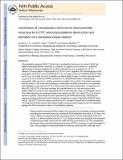| dc.contributor.author | Lohman, Gregory J. S. | |
| dc.contributor.author | Gerfen, Gary J. | |
| dc.contributor.author | Stubbe, JoAnne | |
| dc.date.accessioned | 2012-08-28T15:10:16Z | |
| dc.date.available | 2012-08-28T15:10:16Z | |
| dc.date.issued | 2010-01 | |
| dc.date.submitted | 2010-01 | |
| dc.identifier.issn | 0006-2960 | |
| dc.identifier.issn | 1520-4995 | |
| dc.identifier.uri | http://hdl.handle.net/1721.1/72366 | |
| dc.description.abstract | Ribonucleotide reductase (RNR, 76 kDa) from Lactobacillus leichmannii is a class II RNR that requires adenosylcobalamin (AdoCbl) as a cofactor. It catalyzes the conversion of nucleoside triphosphates to deoxynucleotides and is 100% inactivated by 1 equiv of 2′,2′-difluoro-2′-deoxycytidine 5′-triphosphate (F[subscript 2]CTP) in <2 min. Sephadex G-50 chromatography of the inactivation reaction mixture for 2 min revealed that 0.47 equiv of a sugar moiety is covalently bound to RNR and 0.25 equiv of a cobalt(III) corrin is tightly associated, likely through a covalent interaction with C[subscript 419] (Co−S) in the active site of RNR [Lohman, G. J. S., and Stubbe, J. (2010) Biochemistry 49, DOI: 10.1021/bi902132u]. After 1 h, a similar experiment revealed 0.45 equiv of the Co−S adduct associated with the protein. Thus, at least two pathways are associated with RNR inactivation: one associated with alkylation by the sugar of F[subscript 2]CTP and the second with AdoCbl destruction. To determine the fate of [1′-[superscript 3]H]F2CTP in the latter pathway, the reaction mixture at 2 min was reduced with NaBH[subscript 4] (NaB[superscript 2]H[subscript 4]) and the protein separated from the small molecules using a centrifugation device. The small molecules were dephosphorylated and analyzed by HPLC to reveal 0.25 equiv of a stereoisomer of cytidine, characterized by mass spectrometry and NMR spectroscopy, indicating the trapped nucleotide had lost both of its fluorides and gained an oxygen. High-field ENDOR studies with [1′-[superscript 2]H]F[subscript 2]CTP from the reaction quenched at 30 s revealed a radical that is nucleotide-based. The relationship between this radical and the trapped cytidine analogue provides insight into the nonalkylative pathway for RNR inactivation relative to the alkylative pathway. | en_US |
| dc.description.sponsorship | National Institutes of Health (U.S.) (Grant number GM29595) | en_US |
| dc.language.iso | en_US | |
| dc.publisher | American Chemical Society (ACS) | en_US |
| dc.relation.isversionof | http://dx.doi.org/10.1021/bi9021318 | en_US |
| dc.rights | Article is made available in accordance with the publisher's policy and may be subject to US copyright law. Please refer to the publisher's site for terms of use. | en_US |
| dc.source | PMC | en_US |
| dc.title | Inactivation of Lactobacillus leichmannii ribonucleotide reductase by F2CTP: adenosylcobalamin destruction and formation of a nucleotide based radical | en_US |
| dc.type | Article | en_US |
| dc.identifier.citation | Lohman, Gregory J. S., Gary J. Gerfen, and JoAnne Stubbe. “Inactivation of Lactobacillus Leichmannii Ribonucleotide Reductase by 2′,2′-Difluoro-2′-deoxycytidine 5′-Triphosphate: Adenosylcobalamin Destruction and Formation of a Nucleotide-Based Radical.” Biochemistry 49.7 (2010): 1396–1403. | en_US |
| dc.contributor.department | Massachusetts Institute of Technology. Department of Biology | en_US |
| dc.contributor.department | Massachusetts Institute of Technology. Department of Chemistry | en_US |
| dc.contributor.approver | Stubbe, JoAnne | |
| dc.contributor.mitauthor | Lohman, Gregory J. S. | |
| dc.contributor.mitauthor | Stubbe, JoAnne | |
| dc.relation.journal | Biochemistry | en_US |
| dc.eprint.version | Author's final manuscript | en_US |
| dc.type.uri | http://purl.org/eprint/type/JournalArticle | en_US |
| eprint.status | http://purl.org/eprint/status/PeerReviewed | en_US |
| dspace.orderedauthors | Lohman, Gregory J. S.; Gerfen, Gary J.; Stubbe, JoAnne | en |
| dc.identifier.orcid | https://orcid.org/0000-0001-8076-4489 | |
| mit.license | PUBLISHER_POLICY | en_US |
| mit.metadata.status | Complete | |
| mit.metadata.status | Complete | |
